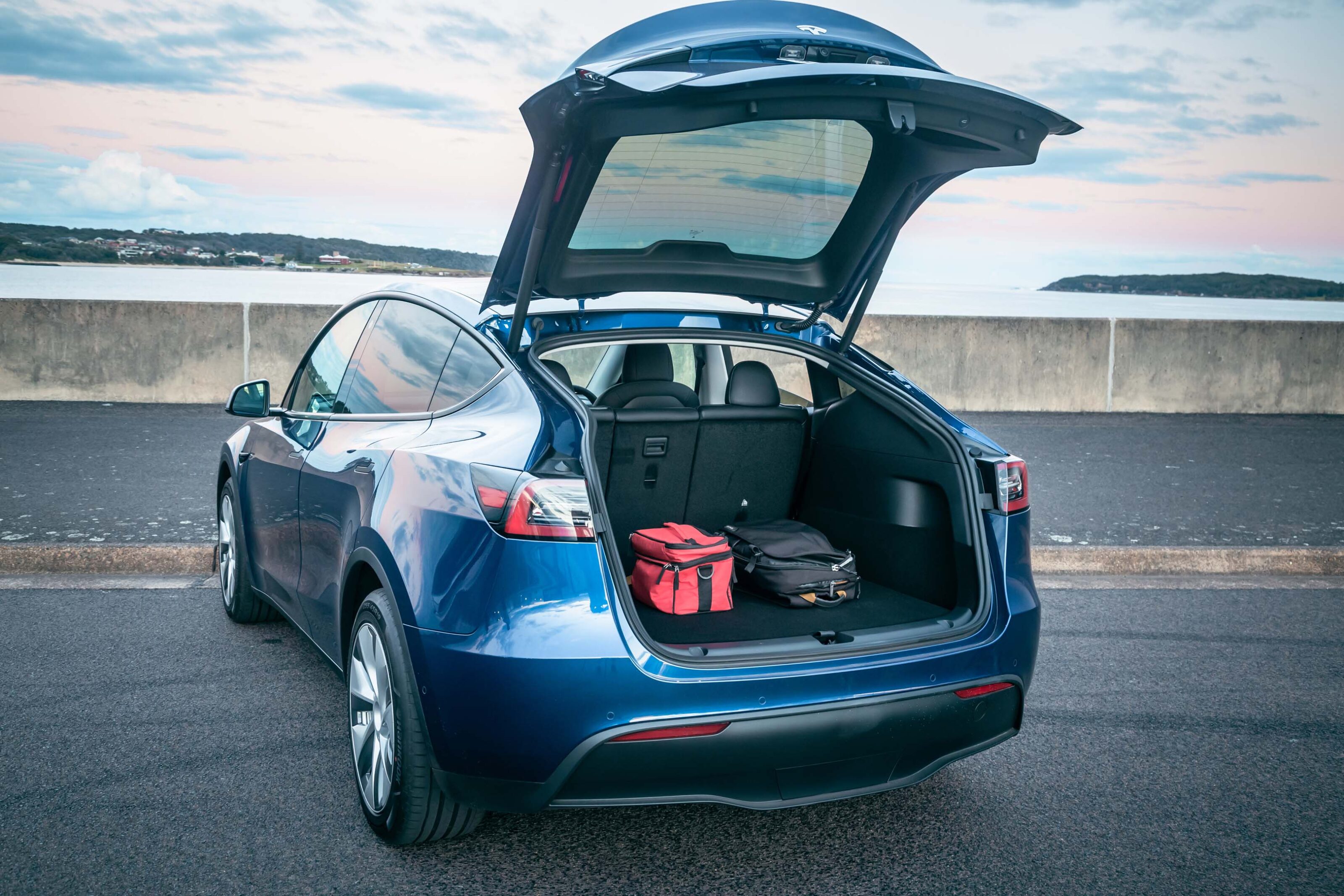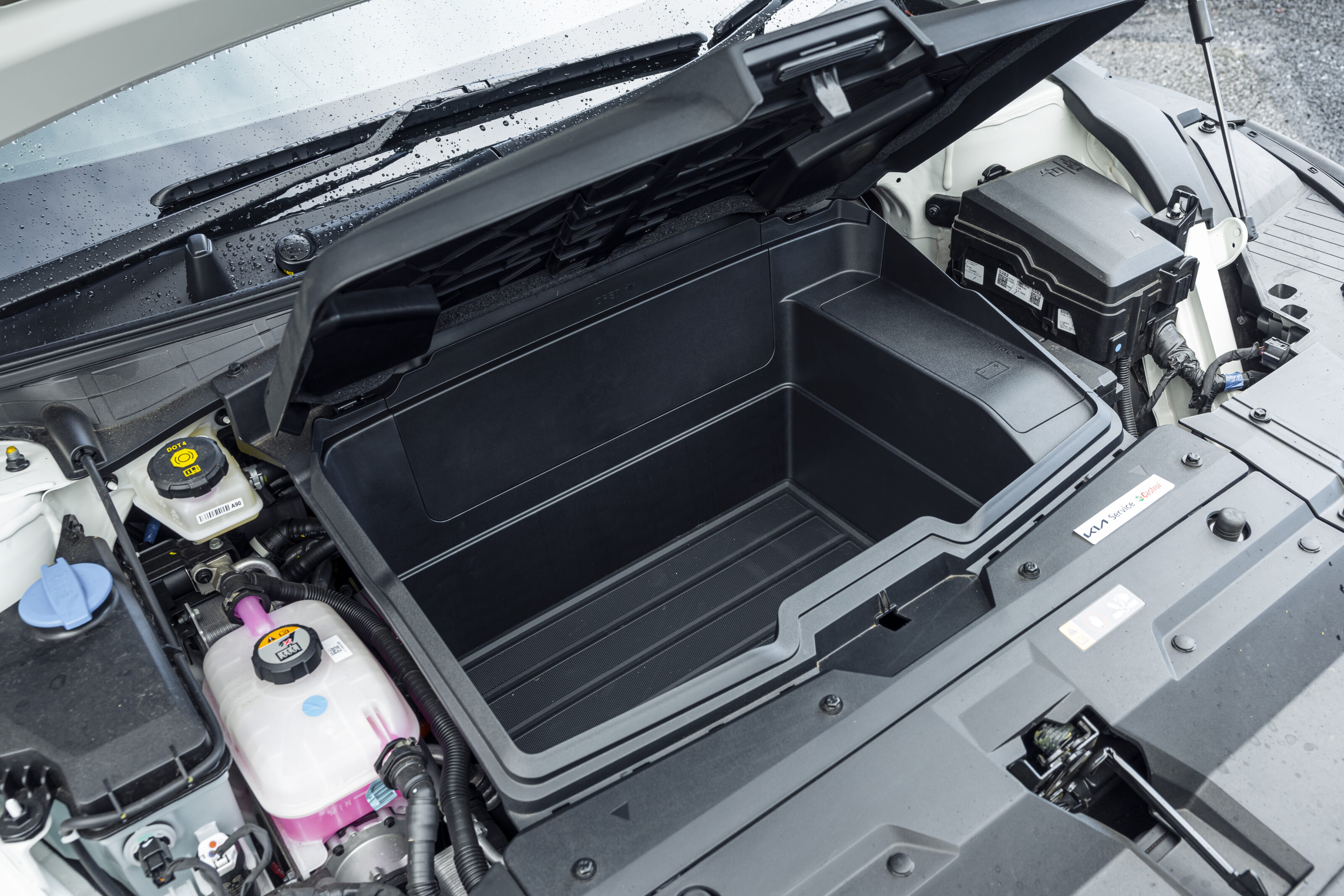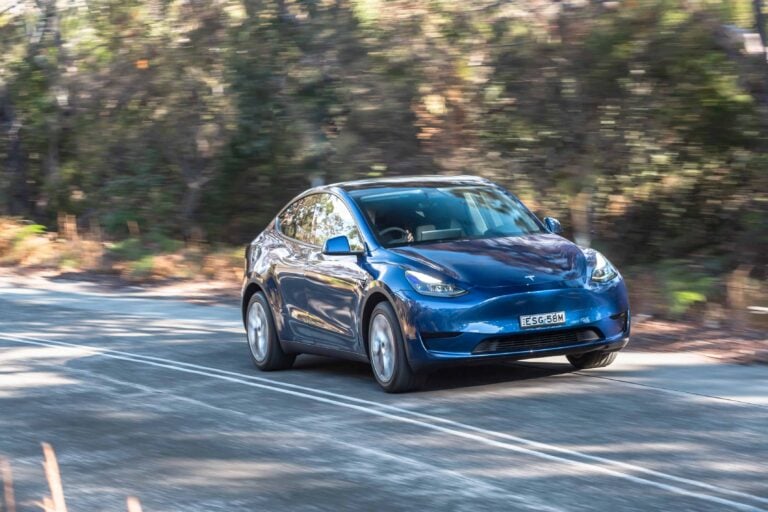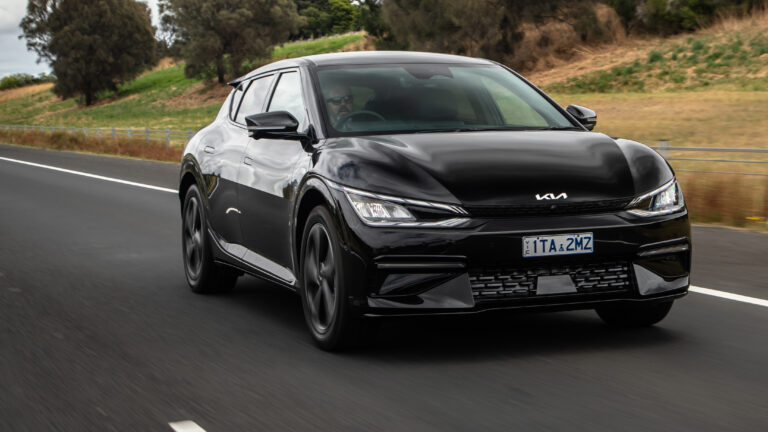
While now in its third year of production, there’s something about the timing of Tesla Model Y’s Australian release that feels about right.
If the Model S and Model X built the church, and the Model 3, the top-selling EV in Australia by a country furlong, spread Tesla’s widespread acceptance beyond the sanctum of devout pilgrims, the Model Y’s mid-sized SUV pitch, looks dressed for success.
“We’re working on accelerating RHD production,” Elon Musk tweeted of versions it manufactures in China. “Didn’t expect demand to be so high.”
One week after Model Y lobbed into local showrooms, with wait times on new orders bolting out to a year or so at last count, Tesla upped the price of the two-variant line-up. It’s another in a long line of move demonstrated by a company that famously – or infamously – plays by its own rules.
Editor’s note: Kia is also improving supply of EV6 to Australia, if in only moderate numbers, with another 100 expected soon.

Tesla’s most broadly palatable model to date arrives in an accelerating groundswell of local interest in tyre-kicking electrification, much of it due to the American company’s growing popularity, a lot of it propelled by fuel prices and a proliferation of new EV releases from elsewhere.
The Model Y enters a level of diverse and viable competition Tesla’s previous releases didn’t have to contend with.
There’s arguably no fitter rival for Tesla Model Y than Kia EV6, its flagship of a three-variant range, the dual-motor GT-Line, the reigning Wheels COTY champ.

Price and specs
The two nameplates make for natural nemeses at entry level, single-motor rear-drive grades.
The EV6 Air RWD, at $67,900, was tantalisingly close to the launch price of the lower-grade Model Y RWD’s $68,900.
At least, that was before Tesla swiftly upped its ante to $72,300 (and closer in pricing to the EV6’s mid-range GT-Line RWD).
Still, this is ground level for two protagonists offering similarly sized five-door, five-seaters serving SUV-crossover roles with pricing at which they’ll be naturally cross-shopped.
Cut and dried? Only to a point.
That’s because in sizing them up, be it for review or as a purchase, the Tesla Y muddies the comparative waters through its maker’s dogged and unorthodox practice of secrecy around what is, in motoring, generally fundamental information – such as power, torque and battery capacity.
The Kia EV6 Air RWD outputs 168kW and 350Nm from its single electric motor and a 77.4kWh battery pack.
Driving range is up to 528 kilometres claimed while delivering 7.3-second 0-100km/h performance and a 185km/h top speed.

Meanwhile, the Tesla Y RWD promises a swifter 6.9-second sprint and a higher 213km/h v-max, though advertised range is, at 455 kilometres, a fair bit short on its Korean rival.
As to the how and whys in technical addenda, well, Tesla isn’t all that inclined to disclose.
Put that down to ‘a tech company making cars’, as some do, even though the likes of Apple, say, divulges the finer technical minutiae of that new MacBook Pro you’ve had your eye on. Tesla’s ploy smacks a little more like Colonel Sanders protecting his 11 secrets herbs and spices.
You could surmise that the Model Y is a 220kW, 420Nm and 60-66kWh proposition in ballpark stats, though Tesla’s schtick – and that’s exactly what it is – is that its machine be sized up on capabilities rather than technicalities. Tesla figures you don’t need to know, even if you want to.
Tesla’s ploy smacks a little more like Colonel Sanders protecting his 11 secrets herbs and spices.

In the Tesla, Autopilot semi-autonomy (adaptive cruise and lane keeping) is standard, though an Enhanced Autopilot ($5100) option can be had that adds Navigate on Autopilot, Auto lane Change, Autopark and Smart Summon functionality.
The EV6 fits some safety features – such as intersection AEB, rear-cross traffic alert and exit warning – not offered on its Tesla rival.
It’s also the only competitor in this twin-test to boast a five-star ANCAP rating.
All EV6 variants including the base Air fit the handy 3.6kW vehicle-to-load facility, under the rear seat bench, that can power appliances, laptops and like, in car on the fly.


Design, interior and space
If you’re new to the Tesla experience, you quickly learn that so much about the hands-on experience is troweled heavily with the sort of schtick that, at times, can cause frustration, yet is the core of its charm.
With its coupe silhouette and an aggregated glasshouse that dwarfs its 19-inch rolling stock, the Model Y appears like a bloated Model 3, lacking the smaller sibling’s neater proportions in a look that’s quite homogenised yet distinctly Tesla.
The EV6 couldn’t appear more different: longer, lower, more ostentatious and futuristic, yet slab-sided and a little awkward in base Air guise bereft of the more upmarket GT-Line’s sporty accoutrement.
Each marks its distinctive presence in a crowd, though neither is the belle of the EV ball.


The Tesla’s high roofline and expansive glass area, extending through to its full-length tinted panoramic roof, pays handsome dividends with the sense of airiness in the cabin, the spaciousness exacerbated by the marque’s signature ultra-minimalist interior design that looks copy and pasted from Model 3.
For what’s such a fundamentally adventurous format, there’s not much distinction or evolution for this new model.
The unusually high front seating offers fantastic outward visibility though it yields slightly unnatural driver ergonomics, in pedal and wheel placement, but you do become acclimatised quickly enough. Some of the rest of the execution, though, demands a longer learning curve.
The huge 15-inch central touchscreen as the access portal and information source for almost any requirement is Tesla’s experiential calling card. And while its intention of streamlining convenience is highly admirable, its hard departure from design convention demands much commitment and habit-breaking. And even then, the format has obvious drawbacks.


In look, detail and general execution it largely mimics a computer screen. It’s crisp, clear and logical to navigate when you’re staring at it and, if you’re like me, wearing your reading glasses.
But for quick-glance legibility as instrumentation, it’s too far from the driver’s line of sight. And for accessing function adjustment most vehicles offer intuitive shortcut controls for, it’s incredibly distracting, compounded by unnecessary submenu digging for basic feature changes. And for either requirement, it’s quite hard to read.
Some motoring convention has been implemented with the wiper/indictor and drive-selector column stalks – perhaps begrudgingly – but much of Tesla’s user experience is compromised by the absence of fundamental features such as a head-up display or proper multifunctional wheel controls.

The EV6’s cabin couldn’t be more different.
Its seating is lower, the ambience feels cosier, the theme is more vibrant and colourful. It’s a vastly fussier and feature-filled, almost achingly stylised, from the floating centre console to the curved display’s dual-12.3-inch display screens that, against the Tesla, makes the Kia feel like the bridge of the Starship Enterprise.
But for all of its overwrought nature and conspicuously techy pitch, the EV6 is wholly intuitive to use and offers a vastly more natural connection at its helm.
The Kia manages to balance the futuristic and the familiar in the right places.
Each EV glams up its cabin with some textural highlights – the fabric dash of the EV6, the wood-like trim garnish in the Model Y – though, on balance, the Tesla feels a little more upmarket.

The Y’s cleaner, simpler execution sidesteps the sort of material diversity the Kia plies, the EV6 exposing more variety of plastic in more areas, some of it not particularly rich, some of it prone to scratches and evident wear.
Further, the fit and finish of our Tesla Y test car, from interior trim work to exterior shut lines, was exceptionally good for a breed that has been persistently kicked for shoddiness in the past.
In terms of solidity and an innate sense of quality, both EVs impress.
Both SUVs offer good second-row space. Unsurprisingly, the Kia’s long cabin, lower roofline and slimmer DLO translates directly into ample legroom if a cosier ambience, though not without a generous amount of all-round space.


But, again, the sheer expanse of the Tesla’s side and roof glass together with its tall form feels to be a more open and airier even though by many measures the cabin isn’t quite as roomy as the Kia.
Either will seat three adults across in reasonable comfort.
Where the Tesla pulls a sizeable advantage inside is with luggage space.
The amalgamation of its long boot and huge underfloor storage tub offers a whopping 854 litres while the Kia makes do with a still-decent 490L. Added to this is superior ‘frunk’ storage of 117L to the EV6’s 52L.
The Tesla also exclusively brings a powered rear seat stowage and an electric tailgate.


On the road
Kia’s Wheels COTY win demonstrated just how accomplished the dual-motor EV6 is as a drive and those qualities translate in this rear-driven Air version. Even given the measurably more modest performance available on tap.
The base EV6 is no firecracker, but its progressive thrust is ample enough to dial up respectable pace from the two-tonne Korean on command.
Around town, its response is more rounded than head-smacking urgent, but there’s enough on tap for instant gap-plugging or sudden overtaking from a cruising velocity.

The three available drive modes present noticeable shifts in throttle take-up but few situations warrant venturing from its middling default.
The Kia’s four-stage brake regeneration system is very handy. At its assertive, one-pedal setting is perfectly calibrated for stop-start traffic, while its zero setting is ideal for a relaxed open-road cruise.
Adjustable via the paddleshifters, it serves scope to not have to constantly apply throttle pressure to maintain or adjust road speed, avoiding fatigue of the right leg muscles when you’re not using cruise control.
In contrast, the Tesla offers no adjustable regen. It offers a range of brake adjusting ‘stopping modes’ via a submenu, but nothing to alter throttle response on the fly, which smacks as a major missed trick.

For its part, though, the two drive modes offered – Chill and Normal – bring calibrations cooperative and flexible enough to just negate the need for driver-selectable regen, though the Tesla does start to get tiring on the right leg muscles during long stints of around-town driving or when you’re not using Autopilot semi-autonomy.
On the march or at a cruise, the Tesla is a little crisper and surlier than the Kia. Flat out, it’s also swifter than the Korean by a measure than aligns with their respective acceleration claims. Fair enough. But with that comes a singular manner – albeit a well-judged one – that just doesn’t quite have the sort of well-rounded, more flexible drivability breadth demonstrated by the EV6’s powertrain.
Those characteristic differences carry over in their respective ride and handling packages.
On the march or at a cruise, the Tesla is a little crisper and surlier than the Kia. Flat out, it’s also swifter than the Korean by a measure than aligns with their respective acceleration claims.

There’s an undeniable sporty undertow the Tesla tries to capture.
Its passive suspension is firm and only manages to drum up acceptable compliance at speed. Around town, it’s downright fidgety and overly terse, perhaps compounded by its low-profile 255/45 rubber, and some of the knocks and noises from the underbody hardware are excessive.
By marked contrast, the EV6 comparatively feels to ride more like a Mercedes-Benz S-Class. Like the Tesla it sits on passive suspension, but compliance is cushy and wonderfully disciplined, maintaining deft body control while smothering all manner of road imperfections.
Its narrower and chunkier 235/55 rubber surely contribute to taking some of the edge off, and there’s not a peep from the rolling stock or underpinnings, bringing a more premium and comfy vibe than the Tesla manages to muster up.

The theme continues with the steering. The Tesla, with a scant two turns lock to lock, is quite alert off centre at any speed, the lack of sneeze factor demanding constant tiny inputs to track a straight line and causing pronounced dartiness in corners.
Across the winding backroad, the combination of its sharp front end and pitchy ride makes for an edgy experience that never really settles into a comfortable groove.
By comparison, the EV6 is measurably more fluid. Be it around town or on a back road, the Kia is much more relaxed and measurably more resolved, its more even steering and front end offering greater pinpoint accuracy. In Sport mode, it’s downright quick, if more relaxed than the Tesla, with fewer foibles and shortcomings.
By comparison, the EV6 is measurably more fluid. Be it around town or on a back road, the Kia is much more relaxed and measurably more resolved, its more even steering and front end offering greater pinpoint accuracy.

Battery, charging and driving range
From fully charged, both EVs were driven as close enough to identically during assessment, never out of eyeshot of each other.
And after a 200-odd-kilometre journey, where remaining range and battery capacity were logged at various points along the way, the projected real-world ranges made for interesting data.
According to onboard logging, the EV6 had used 40 percent of its battery charge, whereas the Model Y had used 58 percent.
Against its 528km claim, the Kia was tracking toward 478kms of real-world range. Meanwhile, the Tesla, with its 455km claim, would run dry at around 334kms.
Peak real-world range is of headlining importance for EV owners heading out of town. And, indeed, it carries much weight in this twin-test’s final verdict. But it’s also just one data set in a much larger picture.
Another key factor is efficiency. And with that, the Tesla returned a more favourable figure of 15kWh/100km during assessed running against the Kia’s on-test result of 16.8kWh/100km.

Against its 528km claim, the Kia was tracking toward 478kms of real-world range. Meanwhile, the Tesla, with its 455km claim, would run dry at around 334kms.
Of course, from here the holistic ownership propositions get more complicated once you open the rabbit hole of recharging. Particularly given that Tesla isn’t willing to make claims of recharge time for its vehicles.
Tesla’s real ace is that owners can use its widespread proprietary Supercharger network as well as public chargers – some 350kW fast-charging, some not (50kW) – that other marque’s EVs, such as Kia’s EV6, are effectively limited to. That’s a helluva dangling carrot Tesla’s way when it comes to convenience benefit.
The jury is out, but some sources suggest that the Tesla Y’s recharge times are not unlike the EV6’s: around 18 minutes for 10 to 80 per cent with 350kW DC fast charging, around 73 minutes using a 50kW charging station, or under eight hours using a typical wallbox charger.

VERDICT
Throw in disparities in equipment and safety (see sidebar) and from a broader viewpoint there’s much to skew buyer preferences and cloud a twin-test verdict. However, it’s the Kia that shines more brightly in core, hands-on goodness that lands the victory Korea’s way.
Ignoring the distraction of trinkets, techno-gimmickry and, yes, schtick, the EV6 is the better all-round drive. It’s comfier, more cooperative and less demanding, while offering a more resolved ride and handling package. In short, it’s more pleasant to spend time in.
The EV6 isn’t the quicker of the two steeds, though as base-level protagonists, extreme performance is no high priority here for this pair. It’s simply nicer, easier and more intuitive to drive with many on-road virtues, and quick enough when you want it to be.

The Kia is also more affordable. And that’s before you factor in some of the State rebates it qualifies for, potentially saving thousands, for which the Tesla doesn’t qualify. Further, Kia’s seven-year warranty trumps the Tesla’s by three years.
The EV6 displayed demonstrably superior potential range. Sure, the Korean marque can’t compete with the advantage of Tesla’s dedicated charging infrastructure (or the phone app connectivity of its rival). But that doesn’t necessarily put it at a disadvantage against the wider EV landscape.
In short, the EV6 Air RWD confidently ticks all of the boxes an entry EV needs to, impressively so, with nary a sign of any compromise or shortcomings.
SCORING
EV6 Air: 8.6/10
Safety, value and features 8.5 Comfort and space 8.5 Engine and gearbox 8.5 Ride and handling 9.0 Technology 8.5
What we like
- Techy and comfy cabin
- Flexible driving character
- Excellent ride and handling
- All-round quality execution
Not so much…
- Frumpy Air styling
- No advanced app connectivity
- Base Air trims off some cool features
- Modest bootspace
Tesla Model Y: 7.9/10
Safety, value and features 8.0 Comfort and space 8.5 Engine and gearbox 8.0 Ride and handling 6.5 Technology 8.5
What we like
- Sense of airiness in cabin
- Improved build quality
- Lots of party tricks
- Supercharger network support
Not so much…
- Chassis lacks ride comfort and fluidity
- No regen adjustment
- Real-world range shortfalls
- 15-inch display interface drawbacks

| Tesla Model Y RWD | Kia EV6 Air RWD | |
|---|---|---|
| $72,300 MSRP | $67,990 MSRP | |
| DRIVETRAIN | ||
| Motor | single | single |
| layout | rear-wheel drive | rear-wheel drive |
| Battery | 60.0kWh-62.3kWh (estimate) | 77.4kWh |
| Power | 220kW (estimate) | 168kW |
| Torque | 420Nm (estimate) | 350Nm |
| Gearbox | single-speed reduction gear | single-speed reduction gear |
| CHASSIS | ||
| Body | steel, 5 doors, 5 seats | steel, 5 doors, 5 seats |
| L/W/H/W-B | 4751/1921/1623/2890mm | 4680/1880/1550/2900mm |
| Track (F/R) | N/A/N/Amm | 1628/1637mm |
| Weight | 1909kg | 2000kg |
| Boot | 854L/Frunk: 117L | 490L/Frunk: 52L |
| Max charge | N/A | 800V |
| Economy | 15.0kWh/100km as tested | 16.8kWh/100km as tested |
| Suspension | Front: A-arms, coil springs, anti-roll bar. Rear: multi-link, coil springs, anti-roll bar | Front: struts, A-arms, anti-roll bar. Rear: multi-link, coil springs, anti-roll bar |
| Steering | electric rack and pinion steering | electric rack and pinion steering |
| Front brakes | ventilated discs (355mm) | ventilated discs (325mm) |
| Rear brakes | solid discs (355mm) | solid discs (325mm) |
| Tyres | Hankook Ventus S1 Evo3 EV | Nexen Nu2019Fera Sport |
| Tyre size | 255/45R19 | 235/55R19 |
| SAFETY | ||
| ANCAP rating | unrated | five star |
| 0-100km/h | 6.9sec claimed | 7.3sec claimed |
We recommend
-
 Reviews
Reviews2022 Tesla Model Y review
Tesla’s Model Y electric SUV is here at last. We find out if it was worth the wait.
-
 Reviews
Reviews2022 Kia EV6 review: Australian first drive
Hyundai got in early with the super-cool Ioniq 5, but now it’s time for the Kia EV6 to impress buyers – even if only a relative handful can have one
-
 News
NewsNew car calendar 2026: All the new cars coming to Australia next year
Here’s the WhichCar by Wheels guide to all the new cars that will launch in Australia in 2026. Check back in regularly for updates...




